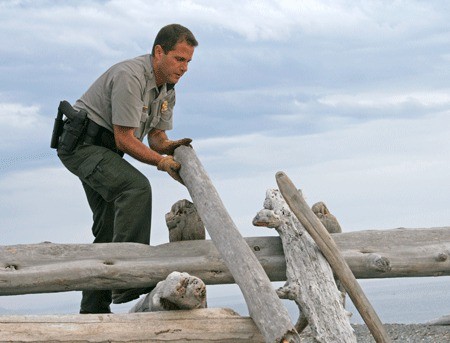It’s about 20 minutes into his daily patrol of American Camp and Chief Ranger Barry Lewis of San Juan Island National Historical Park likes what he sees.
Check that. Rather, it’s more what he doesn’t see that Lewis likes.
No bonfires on the beach or flames spilling out over a fire pit ring. No one loading wood into the rear of a pickup or the back of a car. No one throwing punches or engaging in a fight. And it would appear there are no dogs running off leash.
Shipshape.
So Lewis, a 23-year National Parks Service veteran, who joined the staff of San Juan Island National Parks at the start of the year, shifts his sights.
He spies several bulky, abandoned, makeshift driftwood structures dotting the waterfront at South Beach.
“They’re dangerous, and they’re unsightly,” Lewis said. “They don’t belong in the park.”
Established in 1966, San Juan Island National Historical Park draws roughly 250,000 visitors each year.
The vast majority make their way to American Camp, where, in addition to honoring the U.S. military’s 12-year occupation of that site during the so-called Pig War (1859-1873), the park offers sweeping vistas of Juan de Fuca and Haro straits, miles of hiking trails, an abundance of wildlife, and the many delights of a rugged and expansive waterfront at South Beach.
It’s the type of place where nature dominates the landscape, the frenzied pace of modern day living can quickly evaporate and attention to detail can easily drift away with the comings and goings of the tides.
As a result, it’s also a place where the spirit of outdoor adventure sometimes acts as a Sirens song for both tourists and islanders alike.
And for those sworn to protect the park and its natural resources, like Lewis, that can create conflict.
Unlike state or county parks, Lewis notes recreation is a lesser priority at San Juan’s national historical park. As spelled out in the federal legislation under which the park was created, protection of its natural, historical and cultural resources remain at the top of the priority list .
Dogs running off leash pose a threat park visitors, natural habitat and to the various species of wildlife that live or hunt there.
Lewis said that he’s seen more bald eagles in the park since rangers started issuing tickets rather than warnings beginning in early spring.
“When I first got here about nine out of every 10 dogs I’d see were off leash,” he said. “Now I see one about once a month. We probably have one of the highest rates of compliance in the state.”
Posting signs that are clearly visible has helped, he added.
“It’s pretty hard to come to the park and not see a sign,” he said.
Still, there are occasions when a violation of one of the 36 federal rules enforced at the park warrant a ticket, like feeding wildlife.
Recently, two women who were feeding foxes were issued a ticket each.’
“I think it was cherries and barbecue corn chips,” Lewis recalls.
Though the park has gained better compliance through greater enforcement, Lewis hopes to dispel a perception about it being heavy handed.
He noted the park did not have an enforcement officer in 2010, but that rangers issued 29 tickets the year before, of which more than 15 were for dogs off leash.
So far this year, he said only seven tickets have been issued for dogs off leash.
Lewis acknowledges that the case of a San Juan Island man who he arrested several months ago for interfering with an officer, an incident initiated by a dog off leash ticket, may linger and fan flames of discontent among some islanders over the regimen of enforcement of rules at the park.
The outcome of that case is pending in a federal court in Bellingham.
He believes he’s established a good working relationship with the county Sheriff’s department, local emergency responders and their respective departments, and with the other federal enforcement agencies on the island, such as U.S. Customs and Border Patrol.
“The island has been wonderful in lots of ways,” he said.
Lewis recently established a set of procedures for a “ride-along” program and hopes to initiate a volunteer program as well.
“They could help by being our eyes and ears out in the park,” he said. “There’s a lot of ground to cover.”
He doesn’t expect the need for enforcement to disappear, however.
The park, which now consists of three separate properties, including English Camp to the north, at 849 acres, and newly acquired Mitchell Hill, totaling 312 acres adjacent to English Camp, and its bounty of natural resources offer a temptation that some can’t resist. ‘
Like the 10 people he recently encountered fishing along the waterfront at South Beach.
“Only one of them had a license,” he said.
— For more about San Juan Island National Historical Park, or its rules and regulations, visit, www.nps.gov/sajh/




